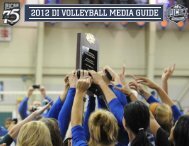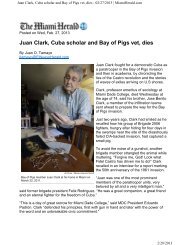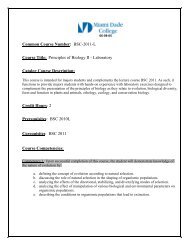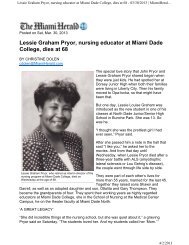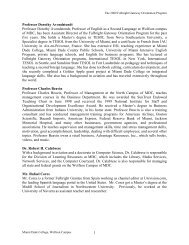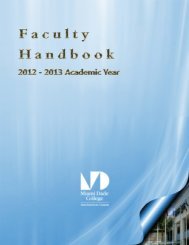Catalog 2010-2012 - Miami Dade College
Catalog 2010-2012 - Miami Dade College
Catalog 2010-2012 - Miami Dade College
Create successful ePaper yourself
Turn your PDF publications into a flip-book with our unique Google optimized e-Paper software.
THE COLLEGE<br />
8<br />
• Quality community partnerships<br />
that serve as the foundation for<br />
the development of relevant workforce,<br />
cultural and civic programs to foster<br />
community service and create a pervasive<br />
understanding throughout the<br />
greater <strong>Miami</strong>-<strong>Dade</strong> County community<br />
of the essential importance of education.<br />
• A commitment to cultural initiatives<br />
that complement academics<br />
and promote the advancement and<br />
appreciation of the arts, thereby contributing<br />
to the richness of our multicultural<br />
community.<br />
• Sustainability practices that distinguish<br />
<strong>Miami</strong> <strong>Dade</strong> <strong>College</strong> as a leading<br />
innovator in educating our students as<br />
contributors to a healthy planet, and as<br />
an institution that accepts its responsibility<br />
to preserve the natural environment.<br />
• Resource development and<br />
operational efficiencies that ensure<br />
effective support for the <strong>College</strong>'s longterm<br />
efforts to provide an innovative<br />
and exemplary learning environment.<br />
Global reach and awareness that<br />
enrich the curriculum and provide a truly<br />
international perspective to students.<br />
MDC History<br />
The ’60s: Opening<br />
Education’s Doors<br />
<strong>Miami</strong> <strong>Dade</strong> <strong>College</strong> opened its doors<br />
as <strong>Dade</strong> County Junior <strong>College</strong> in 1960<br />
amid desegregation and the influx of<br />
thousands of Cuban refugees. In year<br />
one, 1,428 students entered “Chicken<br />
Coop <strong>College</strong>,” nicknamed for the original<br />
buildings that were transformed into<br />
classrooms. The <strong>College</strong> was open to<br />
any county resident who had graduated<br />
from high school. The student body<br />
included the seven black students who<br />
made <strong>Dade</strong> County Junior the first integrated<br />
junior college in Florida. These<br />
students, along with the many Cuban<br />
refugees seeking to better their lives,<br />
paid a $5 application fee, but tuition was<br />
free to all county residents.<br />
By the mid-’60s, the <strong>College</strong> was<br />
already thinking long range. With nearly<br />
15,000 students attending, the original<br />
North Campus buildings were bursting<br />
at the seams. New construction was<br />
under way, with an eye toward not<br />
only a second campus in Kendall, but<br />
a third in downtown <strong>Miami</strong>. By 1967,<br />
the <strong>College</strong> was the largest institution<br />
of higher education in the state of<br />
Florida, enrolling 23,341 students. <strong>Dade</strong><br />
Junior had become the fastest-growing<br />
junior college in the nation. It enrolled<br />
more freshmen than the University of<br />
Florida, Florida State University and the<br />
University of South Florida combined.<br />
The ’70s:<br />
Setting the Standard<br />
In the mid-’70s, the <strong>College</strong>’s guiding<br />
philosophy of “access with excellence”<br />
was clearly defined. A bold education<br />
review reaffirmed the <strong>College</strong>’s opendoor<br />
policy and toughened academic<br />
standards. The project and its goals<br />
became the standard for community colleges<br />
across the country. K. Patricia Cross,<br />
visiting professor at Harvard University’s<br />
Graduate School of Education, called the<br />
<strong>College</strong> “the most exciting institution of<br />
higher education in the country.”<br />
The excitement spread to every<br />
corner of this changing community.<br />
The downtown campus, later to be renamed<br />
for one of the <strong>College</strong>’s founders,<br />
Mitchell Wolfson, was born in 1970. The<br />
Medical Center Campus was founded<br />
in 1977, and bilingual studies became a<br />
full-fledged division in 1979, with more<br />
than 2,000 students enrolled in outreach<br />
centers in the Little Havana area.<br />
These centers would soon become the<br />
InterAmerican Center, the largest bilingual<br />
facility in all of higher education.<br />
The ’80s:<br />
Maturity and Recognition<br />
By the 1983-84 academic year, the<br />
effects of a changing community were<br />
reflected at the community college.<br />
Thirty percent (nearly 18,000 students)<br />
were immigrants, and 46 percent reported<br />
that English was not their native<br />
language. Almost two-thirds of students<br />
enrolled in the <strong>College</strong> were minorities,<br />
and 56 percent were women. Part-time<br />
students were common.<br />
In 1984, the New World School of the<br />
Arts (NWSA) was conceived. Designed to<br />
train future performing and visual artists<br />
from high school through the baccalaureate,<br />
the school became an educational<br />
partnership of <strong>Miami</strong> <strong>Dade</strong> <strong>College</strong>,<br />
<strong>Miami</strong>-<strong>Dade</strong> County Public Schools and<br />
Florida International University, with<br />
FIU handing the baton to the University<br />
of Florida in 1997. Today NWSA is recog-<br />
W W W . M D C . E D U<br />
nized as one of the premier arts conservatories<br />
in the country, with the work of<br />
its graduates gracing venues from New<br />
York to Los Angeles.<br />
1984 also was witness to a modest<br />
<strong>College</strong>-sponsored bookfest on<br />
Kyriakides Plaza at the Wolfson Campus.<br />
“Books by the Bay” drew a surprising<br />
crowd of 25,000 people over two days.<br />
Today, <strong>Miami</strong> Book Fair International is<br />
not only South Florida’s premier cultural<br />
happening, it is the most respected literary<br />
event in the country.<br />
The <strong>College</strong>’s fifth campus, in<br />
Homestead, opened in 1985 at the First<br />
Baptist Church with 350 students. By<br />
1991, a modern campus facility had<br />
been built for South <strong>Dade</strong>’s ever-growing<br />
student population.<br />
With the closing of the decade,<br />
the <strong>College</strong>’s place in education was<br />
nationally recognized: The prestigious<br />
University of Texas Community <strong>College</strong><br />
Leadership Program identified the<br />
<strong>College</strong> as the number one community<br />
college in America.<br />
The ’90s: Ready for<br />
the New Economy<br />
<strong>College</strong> personnel challenged<br />
the mindset of the past by initiating<br />
comprehensive reforms in academic<br />
programs and administrative operations.<br />
The <strong>College</strong>’s Education Review<br />
revamped the academic core and electives<br />
by modernizing the curriculum to<br />
meet the needs of a changing society.<br />
Progressiveness was not limited to education,<br />
as the re-engineering process also<br />
brought improved strategies to human<br />
resources, maintenance operations and<br />
budget formulation. The <strong>College</strong>’s effort<br />
to streamline its bureaucracy and contain<br />
costs brought a new financial stability,<br />
freeing resources for new staff and<br />
program development.<br />
The <strong>College</strong>’s Technology Master<br />
Plan put the <strong>College</strong> on the fast-track<br />
in academic and administrative computing<br />
throughout the 1990s. The <strong>College</strong><br />
sought to keep pace with the changing<br />
economy and workforce, developing<br />
strong partnerships throughout<br />
business and industry. More than 50<br />
new degree and short-term certificate<br />
training programs were developed, all<br />
aimed at emerging industries and South<br />
Florida’s job market. The <strong>College</strong> developed<br />
multimedia classrooms and the



